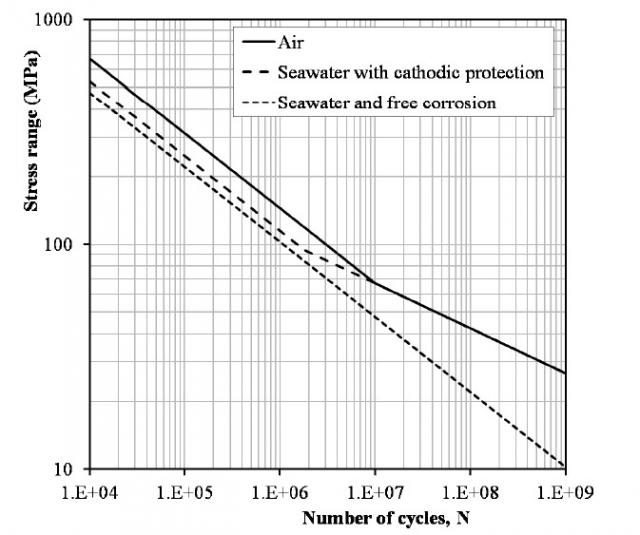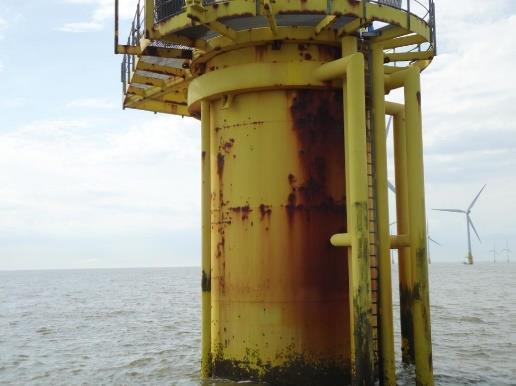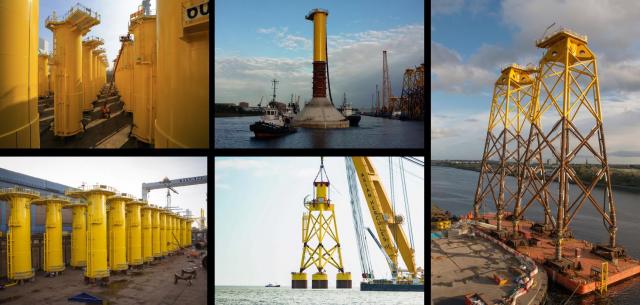FATCOR: Towards a longer lifetime of offshore wind turbine monopile structures by better understanding the fatigue corrosion mechanisms
With the growing interest in deployment of new offshore wind farms in Belgium, Europe and worldwide, it is important to improve the best practices in structural integrity assessment of offshore foundation structures. These welded steel structures are subjected to cyclic loading conditions during operation due to wind, wave and current actions causing fatigue. In addition to fatigue, corrosion plays a significant role in material degradation.
A combination of pitting corrosion, crack initiation and propagation can occur in offshore wind turbine structures, amongst which monopile foundations. The lifetime prediction of a component under corrosion fatigue conditions is challenging because of the need to address the statistics of pit growth, the transition from pit to crack, and subsequent growth in the short and long crack regimes.
For cases where the original corrosion protection system becomes defective, the damage accumulation in periods of corrosive exposure after a period of fatigue without exposure has to be investigated.
It is well known that fatigue failure occurs faster in a corrosive environment than in a neutral environment. Significant research has proven that it is difficult to decouple the evolutions of corrosion damage and fatigue damage. Experiments revealed that fatigue crack growth in a corrosive environment is not just the sum of the metal loss due to corrosion and the crack growth from fatigue.
Project goals
The global ambition is to develop fundamental understanding of the interaction between pitting corrosion and fatigue. The objectives of the PhD project are:
- to numerically determine the stress/strain field around a corrosion pit with or without the presence of a crack.
- to investigate experimentally the initiation of a crack from a pit, and of short crack and long crack propagation. Compare results of fatigue tests in air with corrosion assisted fatigue tests.
- to develop numerical tools for the prediction of remaining fatigue life of a component affected by pitting corrosion.
Project description
The methods applied will be a combination of numerical and experimental investigations.These investigations will be articulated along two axes:
A) degradation of performance due to the presence of corrosion pits,
B) damage accumulation due to cyclic mechanical load and exposure to the corrosive environment (corrosion fatigue).
For steel components with a (weld) crack, the fatigue crack propagation and lifetime can be predicted by fracture mechanics, e.g. the well-known Paris law. However, the size of a pit and the crack initiating from a pit is typically in the range of “short cracks” and does not follow classical fatigue crack growth. Therefore fatigue experiments will be performed on samples with different notch and pit sizes. Single edge notched specimens are extracted from welded plates of S355 steel and will be subjected to 4-point bending fatigue tests in air and in controlled corrosive environment.
The notch sizes will be representative for short cracks and thus related to the grain size of the material. Advanced instrumentation techniques will be employed to characterize the short crack growth regime. Identical specimens also having artificially introduced pits will be fatigue tested. The pit sizes will be determined from representative distributions obtained from specimens retrieved from industrial assets. Test results will allow to bridge the scale of short crack to long crack propagation.
Different pit geometries and sizes will also be investigated by finite element analysis. The stress and strain distribution around the pit and the stress concentration factor will be assessed. This will serve as input to finite element models for lifetime prediction that are concurrently developed in companion projects.
Specific experiments on large scale specimens will also be performed for the determination of S-N curves and to compare to experimental results from small scale experiments performed by partners.
CONSORTIUM
To achieve the overall objectives of the project, a multidisciplinary approach is adopted.The project partners are two windfarm owners (Parkwind and Rentel), a company producing offshore substructures (Iemants), research organisations (Belgian Welding Institute and OCAS) and Ghent University. FatCor is a fundamental research project with financial support of the Energy Transition Fund of the Federal Government of Belgium.

Figure 1 : S-N curve for tubular connections in air and in seawater with cathodic protection [1].

Figure 2 : Example of transition piece, with coating

[1] DNVGL, DNVGL-RP-C203 Fatigue Design of offshore steel structures, 2019.
